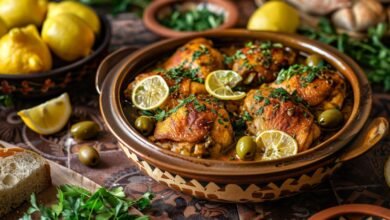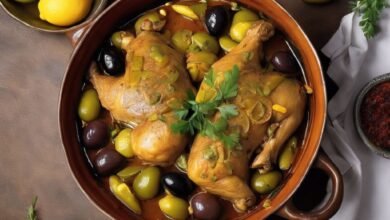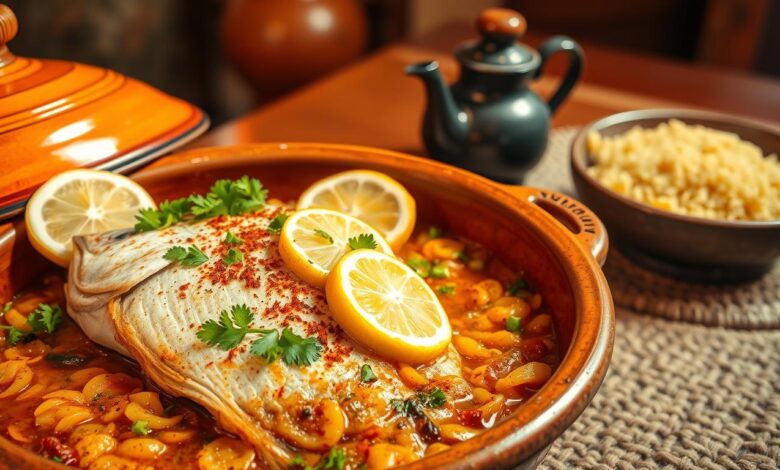
Fish Tagine with Chermoula—One rainy Thursday, you rush home and decide to try a simple North African recipe you spotted online. You pull out a Dutch oven, some white fillets, potatoes, and jars of olives. In less than an hour, the kitchen fills with warm spices and bright citrus.
This is a one-pot approach that makes a bold, fragrant dish feel very doable on a weeknight. You’ll learn a clear, step-by-step method that balances zesty lemon, savory olives, and layered vegetables.
The guide covers gear choices—whether to use a tagine or a Dutch oven—plus stovetop and oven options. You’ll also find tips for mimicking preserved lemons and how chermoula acts as both marinade and sauce to lift simple ingredients into a memorable dinner.
Key Takeaways
- You’ll get an approachable, step-by-step recipe for a flavorful, fish-forward tagine.
- Learn how chermoula transforms plain fillets into something vibrant and fragrant.
- Clear gear guidance helps you choose between a tagine or a Dutch oven.
- Find easy substitutions for preserved lemons and timing tips for tender results.
- Compare stovetop and oven methods so you can adapt to your schedule.
Why You’ll Love This Moroccan Fish Tagine Right Now
A short soak in aromatic paste and low, steady heat make this dish effortless and bold.
Quick prep, long payoff. You marinate the fish briefly, layer onions and potatoes, and let gentle heat do the work. That hands-off simmer saves you time while the flavors deepen.
Bright lemon notes—fresh or preserved lemons—cut through a savory sauce. A few olives and a drizzle of oil add brine and silk. Saffron or a warm spice blend gives extra depth.
- You get citrus and spice balance for a craveable finish.
- Vegetables and fillets cook together so each bite is seasoned.
- Adjust heat and salt easily to suit your family.
| Why it works | Benefit | Easy swap |
|---|---|---|
| Brief marinate | Tender, fragrant fish | Any firm white fillet |
| Layered veg | Hands-off, one-pot meal | Potatoes or root veg |
| Preserved lemons & olives | Tangy, briny notes | Fresh lemon peel and capers |
Ingredients and Smart Substitutions for an Aromatic Tagine
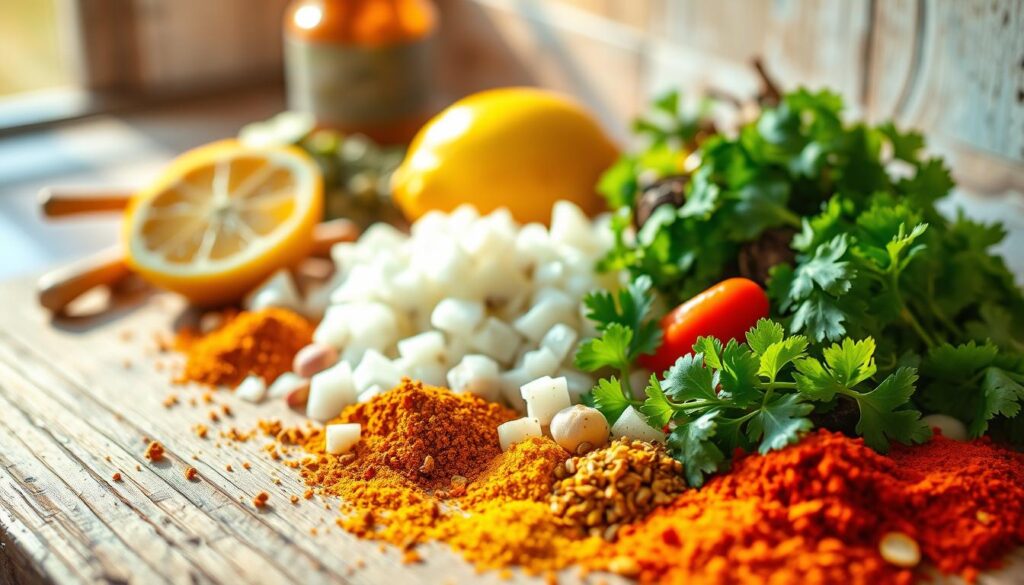
Focus on a few strong ingredients—herbs, citrus, and warm spices—to transform simple white fillets.
Choose the right white fish: pick cod, tilapia, or another firm option so the fillets hold shape during simmering. Portion them evenly for uniform cooking.
Key chermoula components
Build the paste from garlic, cumin, paprika, minced cilantro, lemon zest and lemon juice, plus a generous pour of olive oil. You can add shredded or pureed tomatoes for more body.
Vegetables and pantry add-ins
- Potatoes and sliced onions for texture and sweetness.
- Bell peppers and tomatoes for color and acidity.
- Olives (Kalamata or green) for a briny finish; saffron and turmeric add color and aroma.
| Ingredient | Role | Easy swap |
|---|---|---|
| Cod or tilapia | Holds shape, mild flavor | Any firm, boneless white fillets |
| Cilantro, garlic, cumin | Herby, savory backbone | Parsley or coriander seed (if needed) |
| Preserved lemons | Deep citrus umami | Lemon zest + extra salt + lemon juice |
Spice freely but balance salt. Use Ras el hanout for floral warmth or harissa for heat. Small adjustments let you personalize while keeping the dish true to its spirit.
How to Make Chermoula: The Flavor Bomb Marinade and Sauce
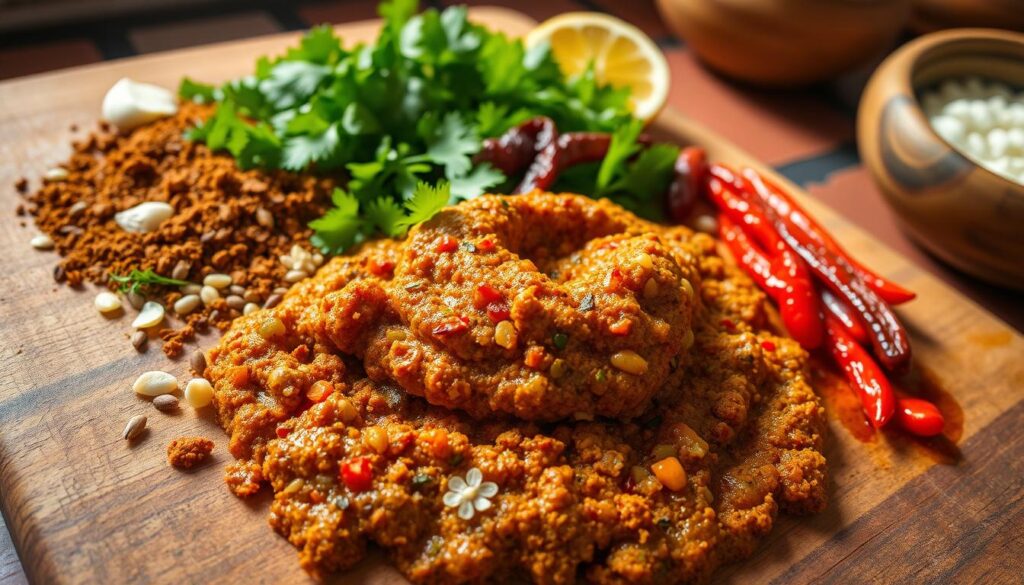
Make a bold herb paste that clings to fillets and loosens into a fragrant simmering sauce.
Step-by-step paste
In a blender, combine shredded or pureed tomatoes, minced cilantro, minced garlic, grated ginger, cumin, paprika, a pinch of turmeric, and sea salt. Add a few tablespoons of saffron water and a splash of olive oil. Pulse until you reach a thick, spoonable paste that will coat your fish yet thin into sauce as it cooks.
Adjusting acidity and salt
Taste and tweak for brightness. Add lemon juice or extra zest to lift the paste. If you need deeper citrus, fold in finely chopped preserved lemon. Add a pinch more salt to balance bitterness and sweetness.
Texture, portioning, and spice choices
- Control texture by pulsing—leave tiny herb flecks for freshness.
- Reserve about a cup if you plan to marinate fillets and sauce the vegetables.
- Stir in Ras el hanout for layered warmth or a spoon of harissa for mild heat.
| Component | Role | Tip |
|---|---|---|
| Tomatoes | Body, sweetness | Use pureed for smoother paste |
| Garlic & cilantro | Herby, savory backbone | Pulse to keep fresh flecks |
| Saffron & oil | Aroma and mouthfeel | A few tablespoons amplify scent |
| Preserved lemon or zest + juice | Citrus depth | Use preserved lemon for intensity |
| Ras el hanout / harissa | Flavor complexity or heat | Add to taste |
Fish Tagine with Chermoula: Step-by-Step Cooking Methods
Get your vessel and tools ready so heat spreads slowly and evenly. Set a heat diffuser under a tagine or Dutch oven to protect the bottom and encourage gentle, steady warmth from the bottom up.
Setup and layering. Start by sautéing oil and minced onion in the base. Layer sliced potatoes, then fillets, and pour about a cup of chermoula over the top so everything bastes as it simmers.
Stovetop method
Bring to a gentle simmer over medium-low and cover tightly. Cook about 60 minutes, adding olives near the end. If the sauce looks dry, stir in a few tablespoons of hot water and cook 10–15 more minutes.
Oven method
Preheat the oven to 400 F. Marinate fillets, nest vegetables or build a layered base, cover with foil, and bake. For a full layered vessel bake about an hour; portioned nests take 12–17 minutes depending on fillet thickness.
Timing and doneness
You’ll know the fish is ready when it turns opaque and flakes easily at the thickest part. Lift fillets from the top carefully, spoon sauce over to finish, and rest briefly so lemon notes settle before serving.
For a guided recipe and extra tips, see the Moroccan fish tagine recipe.
Variations and Pro Tips to Make This Dish Your Own
Small swaps in vegetables and spice levels let you shape this recipe into a weeknight favorite or a festive main.
Whole fish or fillets? You can roast a whole fish stuffed with herbs for a traditional presentation. For fast prep and easy portions, use fillets—no bones to navigate and shorter cook time.
Vegetable swaps and textures. Grate potatoes and carrots to speed cooking and form nests for individual portions. Chop bell peppers for color and add cherry tomatoes for sweet bursts that won’t water down the sauce.
Balancing sweet, heat, and citrus
Dial citrus using preserved lemons or a mix of lemon zest and lemon juice to get bright, layered flavor without harshness.
Tune heat with a spoonful of harissa and add aromatic depth with Ras el hanout. For a subtle sweet-savory contrast, stir in honey or dried fruits like apricots or dates.
- Use cod or other firm options so fillets hold shape and absorb sauce.
- Season in stages—taste after simmering to keep salt and acid balanced.
- Swap between a single-vessel tagine and sheet-pan nests for portioning and ease.
| Variation | Benefit | Quick tip |
|---|---|---|
| Whole fish | Traditional look, bones intact | Stuff cavity with herbs and lemon slices |
| Fillets | Faster, easier portions | Marinate briefly to boost flavor |
| Grated veg nests | Faster cook, neat portions | Press into cups for individual servings |
Final pro tip: Garnish just before serving with chopped herbs or extra preserved lemon to lift aroma and finish the plate.
Serving Ideas, Sides, and How to Store or Freeze Your Tagine
A few smart sides and storage steps turn this into an easy weeknight winner and a make-ahead meal.
What to serve: Offer Moroccan bread or plain white bread so guests can soak up sauce. Or serve couscous or plain rice for a modern plate. Add a crisp cucumber-and-tomato salad to cut richness.
Set a small board of olives and pickled vegetables on the table to echo briny notes and add crunch. Drizzle a little olive oil at the end to lift aroma and sheen.
Store, freeze, and reheat
Portion for flexibility: Batch the sauce into labeled containers and freeze for up to one month. Keep the fish separate for best texture. Remove excess air and freeze flat to save space and speed thaw time.
Thaw in the refrigerator. Reheat the sauce in a pan until piping hot, then nest the thawed fish on top and cook 4–6 minutes until just done. For oven reheats, warm portions at 350–375 F until hot, then place fish on the top and finish gently to avoid overcooking.
- Keep potatoes and peppers slightly al dente on day one so reheated servings retain texture.
- Portion leftovers into single-serve containers for quick lunches or fast dinner reheat.
- Refresh flavors after reheating with a squeeze of lemon juice or a touch of preserved lemon for brightness.
| Step | How | Tip |
|---|---|---|
| Freeze sauce | In labeled containers, up to 1 month | Leave fish separate for best texture |
| Thaw | Refrigerate overnight | Freeze flat to speed thawing |
| Reheat | Simmer sauce, finish fish on top 4–6 minutes | Or rewarm in oven at 350–375 F and finish on top |
Conclusion
Finish the dish by resting it briefly so the citrus and herbs knit into a balanced sauce.
You now have a clear path to a classic fish tagine that balances bright lemons, savory olives, and a vibrant chermoula paste. Use cod or another white fish and adjust salt, cumin, garlic, and cilantro so flavors stay lively without overwhelming the fillets.
Build flavor from the bottom—onions and potatoes—and finish at the top with a spoon of sauce. Follow time cues for oven or stovetop cooking so texture stays tender. For extra guidance, see this practical Moroccan chicken lemon olive tagine example.
Serve on bread or grains, garnish with bell pepper ribbons, and enjoy a dish that feels both comforting and celebratory.

